Installing a wood fence can cost you between $1,700 and $4,000, with typical per linear foot prices ranging from $10 to $50. Cedar, known for its durability, costs about $20 to $35 per linear foot, while more affordable pressure-treated pine costs $10 to $25. Taller fences, around six to eight feet high, will increase your expenses, ranging from $15 to $30 per linear foot. Often affected by your location and project complexity, labor can also significantly impact costs. Additional elements like gates and hardware further influence the total expense. For a detailed breakdown and ways to optimize your budget, continue exploring.
Key Takeaways
- The cost to install a wood fence ranges from $10 to $50 per linear foot, depending on wood type and height.
- Labor costs vary widely based on geographical location, project complexity, and contractor experience.
- Gate installation costs $150 to $600, and hardware costs $50 to $200.
- Staining and sealing services typically cost $1 to $2 per square foot.
- Removing old fencing can cost $3 to $5 per foot, plus potential dumpster rental or professional labor fees.
Types of Wood Fences
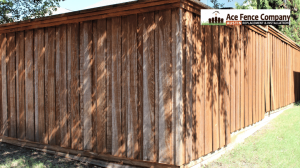 When considering the installation of a wood fence, it’s vital to understand the various types available, as each comes with distinct features and cost implications. One popular option is the classic picket fence, offering a charming aesthetic while providing moderate privacy. The stockade fence style might be more suitable with its tightly placed vertical boards if you want more seclusion. For a blend of privacy and style, the shadowbox fence creates an alternating board pattern that looks appealing from both sides. Wood durability is an essential factor in selecting the right fence style. Cedar fences are renowned for resisting decay and insects, making them a durable choice. Pressure-treated pine is another standard option, known for its affordability and resistance to rot. However, it may require more maintenance over time than more robust woods like redwood, which boasts exceptional longevity and minimal upkeep.
When considering the installation of a wood fence, it’s vital to understand the various types available, as each comes with distinct features and cost implications. One popular option is the classic picket fence, offering a charming aesthetic while providing moderate privacy. The stockade fence style might be more suitable with its tightly placed vertical boards if you want more seclusion. For a blend of privacy and style, the shadowbox fence creates an alternating board pattern that looks appealing from both sides. Wood durability is an essential factor in selecting the right fence style. Cedar fences are renowned for resisting decay and insects, making them a durable choice. Pressure-treated pine is another standard option, known for its affordability and resistance to rot. However, it may require more maintenance over time than more robust woods like redwood, which boasts exceptional longevity and minimal upkeep.
Cost of Different Wood Types
Understanding the cost implications of different wood types is essential for budgeting your fence installation accurately. The type of wood you choose dramatically impacts not only the initial expense but also the longevity and maintenance of your fence. Cedar options are famous for their natural resistance to decay and pests, generally costing between $20 to $35 per linear foot. Pine, known for its durability, especially when pressure treated, is more affordable, ranging from $10 to $25 per linear foot. Redwood, prized for its rich aesthetics and weather resistance, is on the higher end, often costing $25 to $50 per linear foot.
Consider these factors when evaluating wood types:
- Cedar options: Offers excellent weather resistance and requires less wood treatment.
- Pine durability: Pressure-treated pine is cost-effective and long-lasting.
- Redwood aesthetics: Provides a premium look but comes with a higher price tag.
- Wood sourcing: Regional prices can vary significantly based on availability.
- Eco-friendly options: Some woods are more sustainably sourced, affecting cost and environmental impact.
Understanding these cost variations helps you make an informed decision that aligns with your budget and desired fence lifespan. Always compare regional prices and consider the eco-friendly options for a balanced choice.
Fence Height and Length
Considering the height and length of your fence is essential for an accurate cost estimate and ideal functionality. Taller fences, such as those six to eight feet high, provide greater privacy and security but come with increased material costs. For example, depending on the wood type, a six-foot-tall fence may cost between $15 to $30 per linear foot. Shorter fences, around three to four feet high, are often more affordable, costing approximately $10 to $20 per linear foot. The length of your fence is equally essential. Measure your property’s perimeter to get a precise estimate. If you’re enclosing a standard suburban backyard, you need about 150 to 200 linear feet of fencing. For more significant properties, this number could easily double or triple. Remember, height and length impact not just cost but also fence aesthetics and durability. Consider the overall look you desire and how long you want the fence to last. A well-proportioned fence enhances your property’s curb appeal while ensuring lasting durability.
Labor Costs
After determining the ideal height and length for your wood fence, it’s essential to consider the labor costs associated with installation. Labor rates can significantly impact your overall budget, and these costs can vary based on several factors. The complexity of your project plays a vital role in determining labor costs. More intricate designs or challenging terrains can increase the time and effort required, raising expenses.
Here are some key factors to take into account:
- Geographical Location: Labor rates can differ widely based on your region. Urban areas typically command higher rates.
- Project Complexity: Simple, straight-line fences are easier and cheaper to install than those with multiple gates or custom designs.
- Experience of the Contractor: Skilled laborers charge more for their expertise, but they might complete the job more efficiently.
- Time of Year: Demand for fencing services can fluctuate seasonally, potentially affecting labor availability and cost.
- Site Preparation: Pre-existing obstacles like trees or old fences can add to the labor costs due to additional removal and preparation work.
Understanding these variables helps you budget more accurately and guarantees you’re prepared for any fluctuations in labor expenses.
Post and Rail Materials
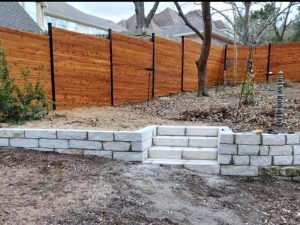 When choosing the materials for your wood fence, post, and rail components are critical elements that require careful consideration. The type of wood you select significantly impacts your fence’s aesthetics and durability. Popular wood types include cedar, pine, and redwood. Cedar is known for its resistance to rot and insects, making it a durable option. Pine is more affordable but requires pressure treatment to withstand the elements. Redwood, while premium-priced, offers natural resistance to decay and a striking appearance. Post spacing is another essential factor. Standard spacing is usually 6 to 8 feet between posts. Closer post spacing, such as 6 feet, provides additional stability and is recommended for areas with high wind. Conversely, 8-foot spacing can reduce material costs but may compromise structural integrity over time. When calculating costs, consider that cedar posts typically range from $10 to $20 each, while rails can cost between $3 and $5 per linear foot. Pine posts and rails are generally more economical, with prices around $5 to $15 per post and $2 to $4 per linear foot. Redwood commands a higher price, reflecting its premium quality and longevity. Choosing suitable materials and post spacing guarantees your fence will stand firm and look beautiful, fostering a sense of belonging and security for your home.
When choosing the materials for your wood fence, post, and rail components are critical elements that require careful consideration. The type of wood you select significantly impacts your fence’s aesthetics and durability. Popular wood types include cedar, pine, and redwood. Cedar is known for its resistance to rot and insects, making it a durable option. Pine is more affordable but requires pressure treatment to withstand the elements. Redwood, while premium-priced, offers natural resistance to decay and a striking appearance. Post spacing is another essential factor. Standard spacing is usually 6 to 8 feet between posts. Closer post spacing, such as 6 feet, provides additional stability and is recommended for areas with high wind. Conversely, 8-foot spacing can reduce material costs but may compromise structural integrity over time. When calculating costs, consider that cedar posts typically range from $10 to $20 each, while rails can cost between $3 and $5 per linear foot. Pine posts and rails are generally more economical, with prices around $5 to $15 per post and $2 to $4 per linear foot. Redwood commands a higher price, reflecting its premium quality and longevity. Choosing suitable materials and post spacing guarantees your fence will stand firm and look beautiful, fostering a sense of belonging and security for your home.
Gates and Hardware
When deciding on gate material, you’ll typically choose between wood, metal, or a combination, with costs ranging from $150 to $600 depending on the complexity and quality. Hardware installation, including hinges, latches, and handles, generally adds an extra $50 to $200. Ensuring proper installation of these components is essential for both functionality and security.
Gate Material Choices
Selecting the suitable gate material is essential for your wood fence’s functionality and aesthetic appeal. The choice you make will directly affect gate styles, gate sizes, gate functionality, and gate security. Additionally, it will influence the gate’s aesthetics and durability, ensuring it complements your fence’s overall design while serving its purpose effectively.
When considering gate material choices, keep in mind the following options:
- Wood: Offers a natural look that matches your fence, providing excellent gate aesthetics but may require more maintenance.
- Metal: Provides superior gate durability and security, with options like wrought iron or aluminum, enhancing gate functionality.
- Vinyl: Low-maintenance and durable, it can mimic wood without upkeep, adding to gate aesthetics and functionality.
- Composite: Combines wood and plastic, offering the best of both worlds regarding gate aesthetics and durability.
- Chain Link: Ideal for security purposes, though less appealing aesthetically, it excels in gate functionality.
Considering these materials will help you make an informed decision, ensuring a seamless gate installation process. Remember to explore gate accessories that can further enhance the utility and longevity of your chosen gate material.
Hardware Installation Costs
Hardware installation costs for gates and hardware can considerably impact the overall budget of your wood fence project. When planning, you must consider expenses for various bolt types, hinges, latches, and other vital components. Each piece of hardware requires specific installation techniques to guarantee durability and security.
Here’s a breakdown of typical costs:
Hardware Component | Estimated Cost | Installation Technique |
Standard Hinges | $10 – $20 | Screw or bolt-on |
Heavy-Duty Hinges | $25 – $50 | Bolt-on with washers |
Basic Latch | $15 – $30 | Screw-on |
Locking Latch | $35 – $60 | Bolt-on |
Gate Bolts | $5 – $15 | Drill and bolt |
Using quality bolt types like galvanized or stainless steel can prevent rust and extend the lifespan of your fence. Standard hinges and latches are sufficient for lightweight gates, but heavy-duty hinges are recommended for more enormous gates to provide additional support and stability. Proper installation techniques, such as ensuring bolts are tightly secured and alignments are accurate, are essential for maintaining the structural integrity of your gate. By carefully selecting your hardware and employing the correct installation methods, you can create a wood fence that looks great and stands the test of time.
Staining and Sealing
Staining and sealing your wood fence is crucial to enhancing its longevity and aesthetic appeal. Properly applied, these treatments protect against moisture, UV radiation, and insects, guaranteeing your investment stands the test of time.
When evaluating staining techniques, you have several options, each with benefits. For example, a brush guarantees deep stain penetration, while a sprayer offers even coverage and faster application.
Here are key points to evaluate:
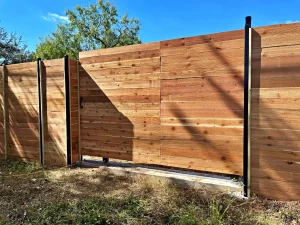
- Staining Techniques: Brush, roller, or sprayer—each method affects the finish and durability.
- Sealing Products: Choose products with UV protection to defend against sun damage.
- Cost Estimates: Expect to spend $1 to $2 per square foot for professional staining and sealing.
- Timing: Ideal application time is during dry weather with temperatures between 50°F and 90°F.
- Maintenance: Reapply stain and sealant every 2-3 years to maintain protection and appearance.
Sealing products often come in water-based or oil-based formulations. Water-based sealants dry faster and have fewer VOCs, while oil-based options offer deeper penetration.
Removal of Old Fencing
Guaranteeing your wood fence is stained correctly and sealed is just one step in maintaining its longevity and appeal. However, the removal process requires careful planning and contemplation when replacing an old fence. You must explore various fence disposal options and recycling materials to guarantee a cost-effective and environmentally friendly approach.
Here’s a breakdown of potential costs and methods:
Task | Estimated Cost |
Manual Removal | $3 – $5 per foot |
Dumpster Rental | $200 – $400 |
Professional Labor | $50 – $70 per hour |
Recycling Services | $10 – $30 |
Transportation Fees | $50 – $100 |
Removing the fence yourself can save money but demands significant labor and time. Hiring professionals guarantees efficiency but increases costs. Renting a dumpster is a practical solution for large amounts of debris, while recycling services offer an eco-friendly alternative, enabling you to repurpose wood and metal components. Evaluating cost and environmental impact is essential when planning to remove old fencing. By effectively managing fence disposal options and recycling materials, you comply with local regulations and contribute to sustainable practices, fostering a sense of community responsibility.
Land Preparation
Proper land preparation is essential for guaranteeing the successful installation of your wood fence. Before you begin, you must evaluate the soil and ensure the site and materials are accessible. Here’s a step-by-step guide to get you started:
- Soil Evaluation: Assess the soil type and stability. Sandy soils may require more profound posts, while clay soils need better drainage.
- Clearing the Area: Remove any vegetation, debris, or obstacles that could interfere with the fence installation.
- Leveling the Ground: Guarantee the ground is as level as possible to avoid uneven fence lines and additional stress on the fence structure.
- Marking the Layout: Using stakes and string to outline the fence’s path guarantees straight lines and accurate measurements.
- Access Planning: Verify site accessibility for equipment and materials. Narrow paths or steep terrain may require special considerations.
Investing time in these steps can help you avoid costly mistakes and guarantee your wood fence stands strong for years. Proper land preparation guarantees a smooth installation process and a solid foundation for your fence, making it a proud addition to your property.
Permits and Regulations
Before installing your wood fence, you must consider local zoning laws and required permit fees, which vary widely. Depending on your municipality, you might face costs ranging from $50 to $200 for permits. Guarantee compliance with height restrictions, boundary regulations, and neighborhood-specific guidelines to avoid legal issues and additional expenses.
Local Zoning Laws
Maneuvering through local zoning laws is essential when installing a wood fence. Understanding zoning restrictions and property lines helps guarantee that your project complies with local fence permits and height regulations. Before you start, check your neighborhood standards and aesthetic guidelines, especially if you live in a historic district. Zoning laws can vary considerably, so it’s critical to be well-informed.
Here’s a quick checklist of what to take into account:
- Zoning Restrictions: Confirm your area’s specific rules regarding fence placement and dimensions.
- Property Lines: Precisely identify your property boundaries to avoid disputes with neighbors.
- Fence Permits: Most locales require permits; verify the application process and necessary documentation.
- Height Regulations: Each area has maximum height limits; exceeding these can result in fines or mandated adjustments.
- Easement Rules: Guarantee your fence doesn’t encroach on easements or utility access areas.
Navigating these elements aligns your project with local laws and maintains neighborhood harmony. Adhering to these regulations fosters a sense of community and belonging, reassuring your neighbors that your new wood fence will enhance, rather than disrupt, the shared environment.
Required Permit Fees
Understanding the required permit fees is critical in installing a wood fence. Before you dig that first post hole, you’ll need to navigate the permit application process and guarantee compliance with local fencing regulations. Permit fees vary widely depending on your location, but generally, you can expect to pay anywhere from $20 to $60. Contact your local building department for detailed information on your area’s specific requirements. Some municipalities charge a flat fee, while others base the cost on the length or height of your fence. For instance, stricter fencing regulations in urban areas could mean higher fees and more detailed inspections. When you’re ready to submit your permit application, be prepared with all necessary documents, such as a site plan and property lines. These documents help confirm that your proposed fence complies with local ordinances. Failing to obtain the correct permits can result in fines or even removing your fence, which can be costly and time-consuming.
Weather Impact on Costs
Weather conditions can significantly affect the overall cost of installing a wood fence. Seasonal fluctuations can lead to variations in labor costs, material prices, and installation timelines. Understanding these factors can help you plan your project more efficiently and budget effectively. During rainy or snowy seasons, the ground can become saturated, making digging post holes and securing the fence more challenging. This can increase labor costs and extend the installation timeline. Conversely, extremely hot weather may cause wood to expand and contract, impacting the stability and longevity of your fence.
Consider these weather-related cost factors:
- Labor Costs: Higher during adverse weather due to increased difficulty and extended work hours.
- Material Prices: Fluctuate with seasonal demand; wood might be more expensive during peak building seasons.
- Installation Timeline: Bad weather can cause delays and potentially added costs.
- Ground Conditions: Wet or frozen ground requires specialized equipment, raising costs.
- Maintenance: Different weather conditions impact long-term fence upkeep, affecting future expenses.
DIY Vs. Professional Installation
When considering DIY versus professional installation for your wood fence, you’ll need to weigh costs, skill requirements, and time investment. DIY installation can save up to 50% on labor costs, but it demands proficiency with tools and accurate measurements. On the other hand, hiring professionals guarantee expertise and efficiency, though it typically adds $15 to $25 per linear foot to your overall expenses.
Cost Comparison
For those considering installing a wood fence, examining the cost differences between a DIY approach and hiring a professional is essential. DIY installation often appears more economical initially, but various factors can influence the final cost. When you go the DIY route, expect to cover the costs of materials, tools, and any unforeseen expenses. Conversely, professional installation typically includes labor, materials, and sometimes even wood fence warranties.
Here are some detailed estimates to help you compare:
- DIY Installation: $8 – $15 per linear foot for materials alone. You might also need to rent or buy specialized tools.
- Professional installation: $30 – $50 per linear foot, including labor and materials. Some companies offer warranties, adding value to your investment.
- Fence Financing Options: Professionals often provide financing plans, making it easier to manage the upfront costs.
- Time Investment: DIY projects can take several weekends, whereas professionals can complete the job in a few days.
- Quality Assurance: Professionals offer expertise and warranties, ensuring your fence is built to last.
Ultimately, your choice depends on your budget, time, and the importance you place on professional quality and warranties.
Skill Requirements
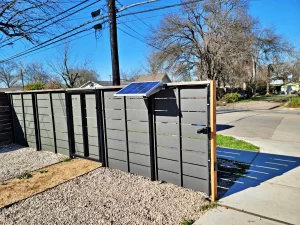 Evaluating the skill requirements for installing a wood fence is essential before deciding between a DIY approach and hiring a professional. You’ll need to consider your proficiency in fence design and installation techniques. DIY installation demands a solid understanding of layout planning, post setting, and panel attachment. Accurate measuring, cutting, and leveling are critical to guarantee a sturdy and aesthetically pleasing fence. If you’ve got carpentry skills and the necessary tools, you might enjoy the hands-on experience and cost savings of a DIY project. However, professional installation offers several advantages. Professionals bring expertise in advanced installation techniques and problem-solving, guaranteeing your fence withstands environmental stresses. They understand local regulations and can manage permits, ensuring compliance. Professionals also have access to commercial-grade materials and tools, which can enhance the durability and finish of your fence design. Additionally, their experience minimizes the risk of costly mistakes and guarantees a faster, more efficient installation process. Ultimately, your decision hinges on your skill level, confidence, and desire for a flawless finish. Hiring a professional might provide peace of mind and long-term satisfaction if you need more clarification about tackling the complexities of fence installation.
Evaluating the skill requirements for installing a wood fence is essential before deciding between a DIY approach and hiring a professional. You’ll need to consider your proficiency in fence design and installation techniques. DIY installation demands a solid understanding of layout planning, post setting, and panel attachment. Accurate measuring, cutting, and leveling are critical to guarantee a sturdy and aesthetically pleasing fence. If you’ve got carpentry skills and the necessary tools, you might enjoy the hands-on experience and cost savings of a DIY project. However, professional installation offers several advantages. Professionals bring expertise in advanced installation techniques and problem-solving, guaranteeing your fence withstands environmental stresses. They understand local regulations and can manage permits, ensuring compliance. Professionals also have access to commercial-grade materials and tools, which can enhance the durability and finish of your fence design. Additionally, their experience minimizes the risk of costly mistakes and guarantees a faster, more efficient installation process. Ultimately, your decision hinges on your skill level, confidence, and desire for a flawless finish. Hiring a professional might provide peace of mind and long-term satisfaction if you need more clarification about tackling the complexities of fence installation.
Time Investment
Time efficiency is essential in installing a wood fence or hiring a professional. Evaluating the installation timeline and project planning are vital factors. When you choose the DIY route, you must factor in the time for each task, from digging post holes to securing each panel. This process can take several weekends, especially if you balance work and other responsibilities. On the other hand, professional installation considerably reduces the project’s duration. Experts bring experience, specialized tools, and a crew, leading to a faster, more efficient process. Generally, a professional team can complete a standard residential wood fence in 1 to 3 days.
Consider these aspects of time investment:
- Preparation: DIY requires extensive project planning, while professionals handle permits and materials.
- Skill Level: Lack of experience can prolong DIY projects.
- Labor Intensity: Digging and setting posts are labor-intensive and time-consuming.
- Weather: DIY projects can be delayed by bad weather, whereas professionals work more efficiently around these issues.
- Quality Control: Pros ensure consistency and reduce the need for future repairs.
Choosing between DIY and professional installation hinges on how much time you can realistically dedicate to the project and your desire for a swift, expertly finished fence.
Additional Features and Accessories
Enhancing your wood fence with additional features and accessories can significantly impact its functionality and aesthetic appeal. Decorative elements like post caps, latticework, and ornamental gates add a personal touch to your fence. Post caps, available in styles from classic to contemporary, typically range from $2 to $15 each. Lattice work adds beauty and privacy, costing between $20 and $40 per panel. Ornamental gates, which serve as an elegant entry point, might set you back $150 to $600, depending on the complexity and materials used. Functional accessories are equally essential. Consider adding gate hardware like hinges, latches, and locks for enhanced security and ease of use. Quality gate hardware ranges from $20 to $100. Additionally, installing a fence stain or sealant preserves the wood and enhances its appearance, costing about $0.50 to $3 per square foot. You should also invest in metal brackets and braces to reinforce the structure, typically costing around $5 to $15 each.
Maintenance Expenses
You can afford to pay attention to maintaining a wood fence if you want it to last. Regular upkeep is essential for fence longevity and can save you from costly repairs. Establishing a maintenance schedule will guarantee that your fence remains in top condition, enhancing its appearance and functionality.
Here are some essential maintenance tasks and their estimated costs:
- Staining or Sealing: Applying a stain or sealant every 2-3 years helps protect the wood from moisture and UV damage. Expect to spend around $150-$300, depending on your fence size.
- Cleaning: An annual wash with a pressure washer costs about $50 if you do it yourself or $150 if you hire a professional.
- Repairs: Fixing minor issues like loose boards or tiny cracks can cost $50-$200. More extensive repairs might set you back $300 or more.
- Pest Control: Treating your fence for termites or other pests could cost approximately $100-$200 per year.
- Inspection: Regular inspections help catch issues early. A professional inspection might cost $75-$100 annually.
Ways to Save Money
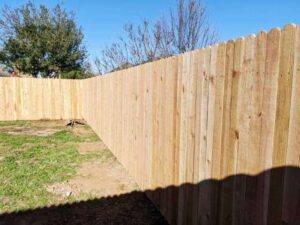 Cutting costs on wood fence installation doesn’t mean you have to compromise on quality. Start by exploring budget-friendly options like pressure-treated pine over more expensive woods like cedar or redwood. Pressure-treated pine typically costs about $10 to $25 per linear foot, compared to cedar, which ranges from $20 to $35 per linear foot. Consider taking a hands-on approach. If you’re handy, installing yourself can save labor costs, which often account for 50% of the total expense. Invest in an excellent post-hole digger and a level to guarantee your fence stands solid and straight. Another smart move is to look into fence financing options. Many suppliers and contractors offer financing plans that can spread out your costs, making it easier to manage your budget. Check for any promotions or discounts available during certain times of the year. Lastly, sourcing materials locally can significantly reduce transportation costs. Local suppliers often have competitive prices and might offer discounts for bulk purchases.
Cutting costs on wood fence installation doesn’t mean you have to compromise on quality. Start by exploring budget-friendly options like pressure-treated pine over more expensive woods like cedar or redwood. Pressure-treated pine typically costs about $10 to $25 per linear foot, compared to cedar, which ranges from $20 to $35 per linear foot. Consider taking a hands-on approach. If you’re handy, installing yourself can save labor costs, which often account for 50% of the total expense. Invest in an excellent post-hole digger and a level to guarantee your fence stands solid and straight. Another smart move is to look into fence financing options. Many suppliers and contractors offer financing plans that can spread out your costs, making it easier to manage your budget. Check for any promotions or discounts available during certain times of the year. Lastly, sourcing materials locally can significantly reduce transportation costs. Local suppliers often have competitive prices and might offer discounts for bulk purchases.
Frequently Asked Questions
How Long Does the Installation Process Typically Take?
The process typically takes 1 to 3 days, considering installation timeframes, depending on your fence’s length and complexity. Labor costs play a significant role during this time. If you opt for professional installers, they’ll efficiently manage tasks like post-setting, panel alignment, and securing materials. This guarantees a sturdy, long-lasting fence. Joining a community of satisfied homeowners, you’ll appreciate the precision and dedication to quality craftsmanship.
Are There Environmentally Friendly Wood Options for Fencing?
There are environmentally friendly wood options for fencing. You can choose sustainable materials like FSC-certified wood, which guarantees responsible forest management. Additionally, look for wood treated with eco-friendly treatments, such as non-toxic sealants and stains. These options reduce your carbon footprint and contribute to a healthier environment.
What Are the Best Practices for Maintaining a Wood Fence?
To maintain your wood fence, apply wood preservation techniques like sealing and staining every 2-3 years. Regularly inspect for damage and repair any broken or rotting sections promptly. Clean your fence annually to remove dirt and mildew. Implementing these fence care tips will extend its lifespan and keep it looking pristine. Your community will appreciate your commitment to maintaining a beautiful and durable fence.
Can I install a wooden fence in a slopped yard?
When installing a wood fence on a sloped yard, you might think it’s an uphill battle, but it’s entirely doable. The key is to choose the right fence design and carefully consider the slope. Use techniques like racking or stepping to guarantee your fence flows smoothly with the terrain. Pay attention to slope considerations to maintain both functionality and aesthetics.
You’ll find belonging in a beautifully tailored landscape.
How Do I Choose the Right Contractor for My Wood Fence Installation?
To choose the right contractor for your wood fence installation, prioritize contractor qualifications and installation experience. Check for proper licensing and insurance, confirming they meet local regulations. Ask for detailed estimates that include labor, materials, and timelines. Review their portfolio for similar projects and read client testimonials. Feel free to ask for explanations of technical terminology to guarantee clear communication. This diligent approach helps you find a skilled contractor who meets your community’s standards.
Conclusion
Installing a wood fence doesn’t have to break the bank if you plan wisely. Like a well-built house, the cost hinges on your choices: wood type, fence dimensions, labor, and additional features. Opting for DIY can save money, but remember, “measure twice, cut once.” Maintenance is ongoing, so budget for future care. You can construct a tall and proud fence without budget surprises by carefully considering these factors. Your dream fence is within reach.


